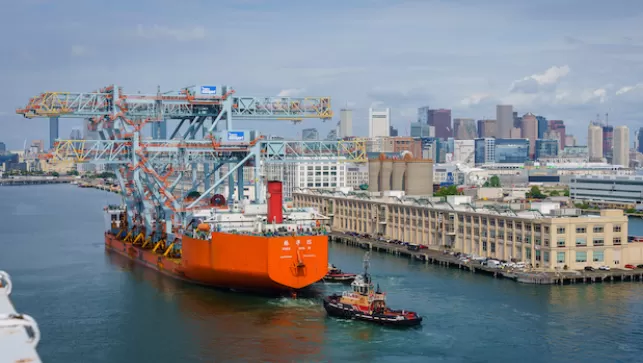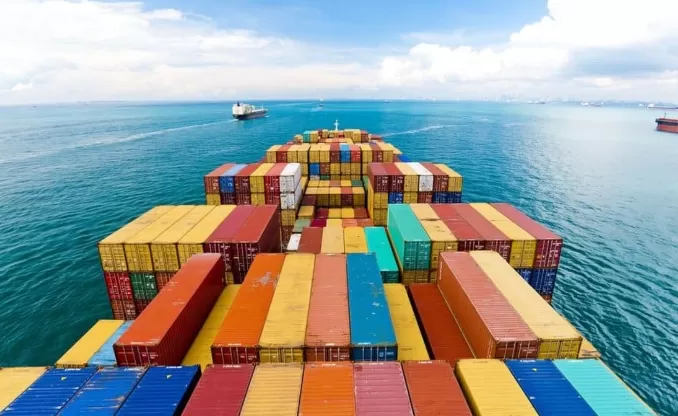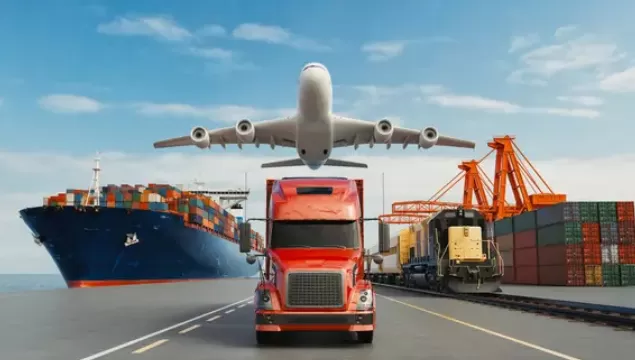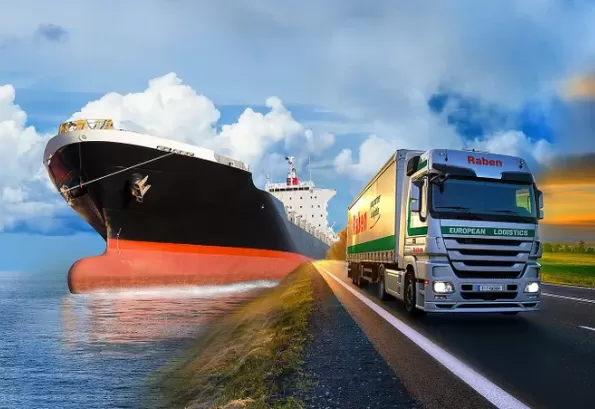Quick Summary (At a Glance)
Sea (FCL): ~28-35 days door-to-door. The actual ocean voyage from Shanghai to Boston is closer to 30-33 days, plus time for port handling and customs.
Sea (LCL): ~35-50 days. It's slower than FCL because your shipment gets grouped with others.
Air freight: ~5-10 days door-to-door. Prices can range from $4–$8/kg or more, heavily dependent on fuel prices and how busy the routes are.
Express (DHL/UPS/FedEx): 2-4 days. Your best bet for small, urgent packages and samples.
Heads up: The shipping world is volatile. Always get live quotes before you book anything. Ocean rates can swing, and air capacity gets tight around peak seasons.
Are you ready?
Get real-time quotes for Boston
Get Quotes
Which Shipping Method is Right for You? (The Quick Decision Guide)
Don't overcomplicate it. Your choice mainly boils down to two things: how soon you need it and how much you're shipping.
Sea FCL (compare to Shipping from China to Los Angeles for West Coast routing). This gives you the lowest cost per item.
If you need it faster (within 10 days) or your goods have high value, choose air freight. You pay more, but you get it much quicker.
If you're just sending samples or a small box (< 150 kg), use an express courier. It's fast, simple, and door-to-door.
Sea Shipping: The Deep Dive - How to Actually Save Time & Money
Forget the textbook definitions. Here’s how ocean freight really works for Boston importers, straight from the pros.
Realistic Timeline: It’s More Than Just Boat Time
Don't be fooled by the "30-day" transit quote. A true door-to-door timeline is a sequential process:
Origin Handling (3-5 days): Trucking to the Chinese port and customs clearance.
Ocean Transit (~33 days): Shanghai to Boston direct sailing.
Destination Handling (5-7 days): Port unloading, customs clearance, and trucking to your Boston warehouse.
→ Your Takeaway: Always plan for 35-45 days total. Book your production and warehouse space accordingly to avoid expensive delays.
FCL vs. LCL: The Real Cost Beyond Price
This isn't just about container size; it's about risk and efficiency.
FCL (Your Own Container):
Pro: Your goods are alone, so it's more secure and faster (no waiting to group cargo).
Con: You pay for the entire container, even if it's not completely full.
→ Do this if: Your cargo fills about three-quarters (75%+) of a 20ft/40ft container. For high-value or lightweight goods, FCL can be safer and more cost-effective even at lower fill rates.
LCL (Shared Container):
Pro: You only pay for the space you use (by cubic meter, CBM).
Con: It's slower (add 1-2 weeks for consolidation/deconsolidation) and your goods are handled more, increasing risk of damage or delay from someone else's paperwork mistake.
→ Do this if: You're shipping less than 15 CBM. The cost of an FCL container wouldn't make sense.
The Boston Routing Secret: You Might Not Be Going to Boston
Besides the type of container, routing selection is the biggest factor affecting cost and timeliness. Here’s the insider tip that can save you big money: Most shipments labeled "Boston" never actually sail directly there.
Why? Direct services to Boston are less frequent. Major hubs like New York/NJ (NYNJ) have dozens more ships arriving weekly, which means more competition and often lower rates.
The Smart Move: It's frequently cheaper and faster to book a container to NYNJ and then arrange a "drayage" truck (short-distance trucking from port to warehouse) for the final ~220-mile leg to Boston. The trucking cost (~$500-$800, this is an estimate; actual rates require real-time quotes) is often outweighed by the ocean savings and greater flexibility.
→ Your Action: Always ask your forwarder for two quotes: one direct to Boston, and one to NYNJ with drayage. Compare the total landed cost and transit time. In most cases, the NYNJ route wins.
Freight Forwarding to Boston
Get real-time quotes for Boston
Get Quotes
Air Freight vs. Express: Choosing the Right Tool for the Job
Think of them as different tools. You wouldn't use a sledgehammer to hang a picture. Here’s how to choose the right one for your shipment.
Which One Are You?
You need AIR FREIGHT if:
Your shipment is over 150 kg (330 lbs) or consists of multiple pallets.
You have flexibility on the exact day of pickup and delivery (you or your agent will handle it).
Cost Focus: You're paying for space on an aircraft. You'll get a rate per kilogram (~$4.50–$9.00+/kg, highly volatile), which becomes more economical at higher weights.
You need EXPRESS (DHL/UPS/FedEx) if:
Your shipment is under 150 kg and is a few boxes or pallets.
You need door-to-door, time-definite speed and want one company to handle everything.
Cost Focus: You're paying for a complete service. Rates are based on weight and volume, often with a premium for speed.
Cost Watch: The Devil's in the Details (and the Surcharges)
The quoted rate is never the final story. Always ask what's included.
Air Freight rates are base prices. You will almost always pay extra for:
Fuel Surcharge (FSC): A significant add-on, fluctuates with oil prices.
Security Surcharge: A fixed fee for screening.
Terminal Handling Fees (THC): Charged at the origin and destination airports.
Express rates are more all-inclusive, but watch for:
Peak Season Surcharges: Especially around holidays.
Remote Area Surcharges: If your warehouse is outside a major urban center.
The Pro's Secret: The Hybrid Approach (Air Freight + Express Cartage)
To combat these hidden costs, savvy shippers sometimes use a hybrid approach. Here’s an insider trick to save money on medium-sized shipments:
Book your shipment as Air Freight from China to the major destination airport (e.g., BOS, JFK, ORD).
Instead of using your agent's expensive trucking service, hire a local express courier (like DHL/FedEx Freight) to pick up the pallet from the airport cargo terminal and deliver it to your door.
→ Why do this? This introduces competition on the final leg and can significantly reduce your total landed cost. It requires more coordination but is often worth it.
→ Your Action: For any air quote, ask for it to be broken down into air transport and trucking (cartage). Then, get a separate quote from a courier for the cartage portion to see if the hybrid model works for you.
For Amazon & E-commerce Sellers: Your Niche Shipping Options
You've got more choices than just plain sea or air. Here’s how to decode the services designed for you.
Mixed transport modes
Get real-time quotes for Boston
Get Quotes
Door-to-Door / DDP
What it is: The easiest, most hands-off option. Your supplier or forwarder handles everything from picking up the goods at the factory in China to delivering them to your warehouse door in the US. They handle all the logistics, customs clearance, and fees. You just pay one invoice.
Good for: First-time importers or anyone who doesn't want the hassle. It's the ultimate in simplicity.
Watch out: This is usually the most expensive option because you're paying for a full-service package.
Port-to-Port
What it is: You only pay for the ocean voyage. You (or your agent) are responsible for trucking the container to the port in China, and then again for all US-side costs: port fees, customs clearance, trucking from the US port to your door.
Good for: Experienced shippers with their own reliable US Customs Broker and drayage trucking company. It can offer the lowest base ocean cost.
Watch out: This is high-risk if you're new. You are responsible for a complex chain of events in the US. Unexpected fees (demurrage, detention) and delays can quickly erase any initial savings.
Sea + Express Piggyback
What it is: Your LCL shipment sails to a West Coast port (like LA/Long Beach). After deconsolidation, it's handed off to a local express carrier (like UPS or FedEx) for the final delivery.
👍 Good for: Smaller shipments (2-20 CBM) going to any address. It's "hands-off" and convenient.
👎 Watch out: Can be more expensive per CBM than海卡. Also, be aware of peak season delays. Express networks get jammed during holidays, which can cause delays after your goods already arrived in the US.
Sea + Truck
What it is: Your LCL or FCL shipment arrives at a port. After customs clearance, the entire container or your pallets are loaded onto a dedicated truck for final delivery.
👍 Good for: Large shipments (15+ CBM) or full containers. It typically offers the lowest per CBM cost for cross-country delivery to a single destination like an Amazon FC that accepts full truckload (FTL) deliveries.
👎 Watch out: You need to schedule the truck delivery and someone must be there to unload.
Shipping to Amazon FBA: The Non-Negotiable Checklist
✅ FBA Labeling is King: Every single unit MUST have its own FNSKU barcode label. Your supplier or you must apply them correctly. Double-check a sample.
✅ Pallet Requirements: Pallets must be Amazon-compliant (e.g., wood pallets must be heat-treated and stamped with IPPC marks). They cannot overhang.
✅ Appointment Only: Your trucker MUST book an appointment with Amazon's receiving warehouse. You can't just show up. Delays here incur massive demurrage fees from the trucking company.
✅PO Accuracy: The Purchase Order number from Amazon must be perfect on the paperwork. The quantity and description of goods must match exactly what Amazon is expecting.
→ Your Action: Never assume your freight forwarder knows all of Amazon's rules. YOU are ultimately responsible. Always send them Amazon's required guidelines and confirm they will follow them.
Freight Rate Reference Table (Estimates Only)
Rates fluctuate daily depending on fuel, seasonality, and capacity. Always request live quotes before booking.
| Mode |
Typical Door-to-Door Transit (est.) |
Price Range (est., USD) |
What’s Included / Notes |
Sources |
| Sea — FCL (40') |
28–35 days (voyage ~30–33 days + port/clearance) |
$2,800 – $4,200 / 40' |
Base ocean freight only. Excludes surcharges (BAF/CAF), docs, drayage, duties. Final invoice often 20–60% higher than base freight. |
Freightos FBX; FluentCargo |
| Sea — FCL (20') |
28–35 days |
$1,800 – $3,000 / 20' |
Smaller container, good for heavy/dense cargo. Priced by carrier/forwarder. |
Freightos FBX |
| Sea — LCL (per CBM) |
35–50 days (includes consolidation/deconsolidation) |
$80 – $200 / CBM |
Charges by volume. Expect extra handling fees. If near ~15 CBM, compare with FCL. |
Freightos LCL tool; industry data |
| Air freight (cargo, >150 kg) |
5–10 days |
$4.00 – $8.00 / kg |
Charged by actual or volumetric weight. Extra: fuel, security, terminal fees. |
Freightos FAX; IATA |
| Express (DHL / UPS / FedEx) |
1–4 days |
Small parcels (1–10 kg): $60 – $250 / shipment |
Door-to-door, usually includes customs clearance. Extra fees in peak/remote areas. |
DHL / UPS service guides |
| Drayage: NY/NJ → Boston (full container) |
1–3 days (port to warehouse) |
$1,200 – $1,900 / 40' (all-in) |
Includes line-haul, chassis, fuel surcharge. Rates vary by season and congestion. |
Drayage board data |
| Local drayage (Boston area, per 40') |
1–3 days |
$325 – $850 / 40' |
Short-haul from port to local warehouse. Higher if night/weekend, waiting time, or special equipment. |
Local drayage samples |
Amazon FBA
Get real-time quotes for Boston
Get Quotes
Customs & Paperwork: Don't Get Stuck Here!
This is where most delays happen. Get your documents right.
You MUST Have:
Commercial Invoice (What is it and what's it worth?)
Packing List (How is it packed and how many are there?)
Bill of Lading (Ocean) or Air Waybill (Air) (The contract for carriage)
The ISF is critical! For ocean shipments, the Importer Security Filing (ISF) must be submitted to U.S. Customs at least 24 hours before the cargo is loaded onto the ship in China. If you don't do this, you face big fines and delays. Your freight forwarder or customs broker usually handles this.
Do You Need a Broker? For your first few shipments, yes, absolutely. A good customs broker navigates the rules for you, files the right forms, and deals with customs if there's an inspection. It's worth the fee.
A Real-World Example: SME Case Study
Scenario: "MapleTech" is shipping one 40 ft container of electronics from Shenzhen to an Amazon warehouse in New Jersey.
Decision: Sea FCL to NY/NJ port, then truck to Amazon. Cheaper than air and perfect for inventory restocking.
Estimated Cost Breakdown:
Ocean Freight (40ft to NY/NJ): ~$2,500 - $4,500 (varies wildly!)
Fuel & Carrier Surcharges: ~$500
Customs Duties & Taxes: ~$1,200 (depends on your product)
Port Fees & Customs Clearance: ~$600
Trucking from NY to NJ Amazon Warehouse: ~$250
Insurance (0.3% of cargo value): ~Varies
Total Estimated Landed Cost: ~$5,050 - $7,050+
The Pro Tip: Consolidating smaller orders into one full container (FCL) can save you up to 30% per unit compared to shipping multiple LCL shipments.
Remember: These numbers are estimates. Your costs will vary. Get quotes!
Practical Tips & Common Pitfalls
Peak Seasons: Expect delays and higher rates from August to October (peak retail season) and before Chinese New Year (factory closures in Jan/Feb). Book early.
Get Multiple Quotes: Don't just go with the first forwarder. Use a platform like Freightos or get quotes from 2-3 different companies.
Double-Check Your Documents: A tiny mistake on the commercial invoice or HS code can hold your shipment in customs for days. Be precise.
Understand Incoterms: Know who is responsible for what. If you're buying FOB, you control the shipping from the Chinese port onward. If you're buying EXW, you're responsible for everything. DDP means the seller handles everything (easiest for you, but usually built into a higher product cost).
FAQ (Short & Sweet Answers)
East Coast (Boston) vs West Coast (LA): which is cheaper?
Short: It depends — West Coast has more direct Asia services; to reach East Coast compare landed cost (ocean + drayage) vs direct Boston services.
FCL vs LCL — which should I pick?
Short: If you can fill a container → FCL; otherwise LCL but expect longer handling time and potentially higher $/unit.
Express vs air cargo — what's the difference?
Short: Express = courier door-to-door for parcels; air cargo = airline freight for pallets/large shipments.
How long does customs clearance in Boston take?
Short: If docs are correct, 1–3 business days is common; inspections or missing paperwork add days.
How to estimate air freight per-kg cost?
Short: Use Freightos FAX for lane benchmarks; typical ballpark $3–$6/kg (est.), but always request a lane quote.
Do I need a customs broker?
Short: Strongly recommended for ocean FCL and first-time importers; brokers manage ISF, entries and duties.
Can I ship directly to Amazon FBA in Boston?
Short: Many east-coast FBA warehouses are actually in NJ/PA/NY — confirm Amazon’s specified inbound warehouse and routing.
What's the difference between DDP and DDU, and which should I choose?
Short: Always choose DDP if you can. It makes costing predictable and saves you the hassle of dealing with customs payments.
My shipment is delayed. How do I find out where it is and what to do?
Short: First, check your Bill of Lading (B/L) or Air Waybill (AWB) number on the shipping line's or airline's official website for the real-time status.
How do I calculate the total 'landed cost' per unit to know my profit?
Short: (Product Cost + Shipping Cost + Customs Duty + Insurance + Any Other Fees) / Total Units = Landed Cost per Unit.
What if my shipment gets damaged or lost? What's the claims process?
Short: Document everything with photos and file a claim with the insurance company or the carrier within the stated time window.

 EN
EN
 FR
FR
 ES
ES
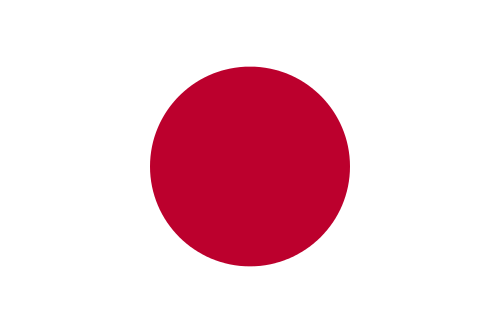 JA
JA
 PT
PT
 RU
RU
 AR
AR
